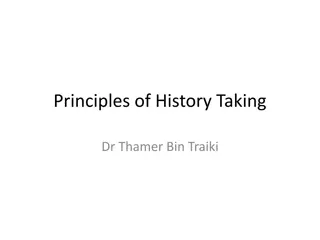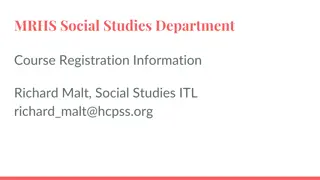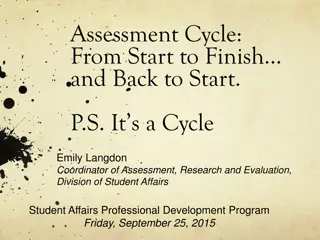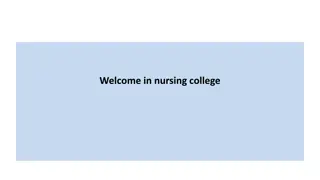Higher History Course Assessment Overview
This document provides a detailed overview of the Higher History course assessment, highlighting changes in structure and content. It includes information on assessment specifications for topics like the Atlantic Slave Trade and the Making of Modern Britain. Candidates will now write extended responses in sections focusing on British, European, and World history, with evaluations and assessments of key historical issues. The assessment format now includes three sections with a total of 60 marks over 2 hours and 20 minutes.
Download Presentation

Please find below an Image/Link to download the presentation.
The content on the website is provided AS IS for your information and personal use only. It may not be sold, licensed, or shared on other websites without obtaining consent from the author.If you encounter any issues during the download, it is possible that the publisher has removed the file from their server.
You are allowed to download the files provided on this website for personal or commercial use, subject to the condition that they are used lawfully. All files are the property of their respective owners.
The content on the website is provided AS IS for your information and personal use only. It may not be sold, licensed, or shared on other websites without obtaining consent from the author.
E N D
Presentation Transcript
The new Higher History Denise Dunlop Subject Implementation Manager Denise.Dunlop@sqa.org.uk
The new Higher History Extended Response Questions (20 marks)
Old Higher External Assessment New Higher External Assessment Two Papers Paper 1 and Paper 2 One Paper (2 hours and 20 minutes) Paper 1 Two Essays Questions Section 2 & 3 Two Extended Response Questions British European & World 20 marks each Knowledge (6 marks) British European & World 20 marks each Use of Knowledge (6 marks) Structure (4 marks) (Introduction & Conclusion) Historical context (2 marks) Conclusion (2 marks) Argument (10 marks) Analysis (6 marks) Evaluation (4 marks)
Timing 2 hours 20 minutes/60 marks No longer a Paper 1 and Paper 2 Section 1 Scottish 3 questions 4 sources 20 marks Section 2 British 1 Extended Response from a choice of 3 questions 20 marks Section 3 European and World 1 Extended Response from a choice of 3 questions 20 marks
SECTION 2 BRITISH 20 marks SECTION 3 EUROPEAN AND WORLD 20 marks Sections 2 and 3 ask candidates to write an extended response. In each section, candidates will have a choice of three questions, each of which will relate to a different issue. Two main types of question will be asked: O Evaluate factors (An evaluation of the reasons for .) O Make an assessment (An assessment of .) (Course Assessment Specification)
Higher History Course Assessment Specification (C737 76) Part C: The Atlantic Slave Trade An evaluation of the reasons for the development of the slave trade An assessment of the importance of the slave trade to the British economy An evaluation of the factors governing relations between slaves and their owners An assessment of the implications of the trade for African societies An evaluation of the obstacles to abolition An evaluation for the reasons for the success of the abolitionist campaign in 1807 Part D: The Making of Modern Britain, 1851 1951 An evaluation of the reasons why Britain became more democratic, 1851 1928 An assessment of how democratic Britain became, 1867 1928 An evaluation of the reasons why women won greater political equality by 1928 An evaluation of the reasons why the Liberals introduced social welfare reforms, 1906 1914 An assessment of the effectiveness of the Liberal social welfare reforms An assessment of the effectiveness of the Labour social welfare reforms, 1945 1951
Historical Study: British Part Three: The Atlantic Slave Trade Historical Study: European and World Part One: The Crusades, 1071 1204 Matching Issues, eg. 2,4,6 (3 issues will not be examined) No fixed topics A study of religious, political and economic factors in the crusading movement between 1071 and 1204, illustrating the themes of ideology, authority and conflict. A study of the development of the Atlantic Slave Trade in the 18th century, the social and economic consequences of that trade, and its abolition in 1807, illustrating the themes of ideology, rights and conflict. Mandatory content Illustrative areas Mandatory content Illustrative areas Military factors; importance of West Indian colonies; shortage of labour; failure of alternative sources; legal position; racist attitudes; religious factors. 1. An evaluation of the reasons for the development of the slave trade The threat to Byzantium; fear of Islamic expansion; the threat to Mediterranean trade; attempts to assert Papal authority: the ongoing struggle between church and state the Investiture Contest; the emergence of a knightly class the idea of chivalry; papal desire to channel the aggressive nature of feudal society. 1. An evaluation of the reasons for the calling of the First Crusade 2. An assessment of the importance of the slave trade to the British economy The importance of tropical crops and the profits accruing; the role of the trade in terms of navigation, manufacturing, the procurement of raw materials and trading patterns; industrial development; wealth of ports and merchants. Religious motives; the desire to acquire territory in the Holy Land; seeking of fame and riches; peer pressure; overpopulation and famine; the sense of adventure. 2. An evaluation of the motives of Christians from different classes to take the cross 3. An evaluation of the factors governing relations between slaves and their owners Humanitarian concerns; religious concerns; financial considerations; fear of revolt; racism and prejudice. 4. An assessment of the implications of the trade for African societies The military power of the Crusader knights; divisions among the Islamic states; misunderstanding of the Crusaders intent; aid from Byzantium; the religious zeal of the Crusaders. 3. An evaluation of the reasons for the success of the First Crusade Effects of the trade on African societies in West Africa; the slave sellers and European factories on the West African coast; the development of slave- based states and economies; the destruction of societies; the development of foreign colonies: roles played by leaders of African societies in continuing the trade. The death of Baldwin IV; divisions among the Crusaders; the lack of resources of the Christian states; the unification of the Islamic states under Saladin; the Christian defeat at Hattin. 4. An evaluation of the reasons for the fall of Jerusalem in 1187 5. An evaluation of the obstacles to abolition Slave rebellion in St Domingue; effects of the French Revolution; importance of the trade to the British economy; fears over national security; the power of vested interests; anti-abolition propaganda; attitudes of British governments. 6. An evaluation for the reasons for the success of the abolitionist campaign in 1807 Richard and Saladin: their military and diplomatic strengths and weaknesses. 5. An assessment of the roles of Richard and Saladin during the Third Crusade Coexistence of Muslim and Christian states; corruption of the crusading movement by the Church and nobles; the effects of trade; the Fourth Crusade; the role of Venice. 6. An assessment of the extent of the decline of the crusading ideal, up to the Fourth Crusade, 1204 Economic factors the decline in the economic importance of slavery; effects of slave resistance; military factors; the religious revival; the campaign of the Anti-Slavery Society; the role of Wilberforce.
SECTION 2 BRITISH 20 marks Question type 1 - Evaluating factors This question will have an isolated factor. To what extent .? How important .? To what extent was the growth of democracy in Britain after 1851 due to the role of pressure groups? It could be presented in the form of a quotation. For example The growth of democracy after 1851 was mainly due to the role of pressure groups How valid is this view? Candidates are expected to evaluate the importance of the isolated factor (the role of pressure groups) and compare it with the importance of other factors (the effects of industrialisation and urbanisation, changing political attitudes, political advantage, the effects of the First World War ) in order to come to a balanced conclusion.
SECTION 2 BRITISH 20 marks Question type 2 Making an assessment This question asks for a balancing of the evidence and analysis and evaluation for and against the success/effectiveness or nature of a development . For example To what extent was Britain a fully democratic country by 1928? This type of question can also be presented in the form of a quotation. By 1928, Britain was a fully democratic country How valid is this view? Candidates are expected to balance the evidence and analysis and evaluation for and against whether Britain was a fully democratic country by 1928 and present a balanced conclusion. An evaluation and an assessment of a development may appear in the same question paper. The same stems can introduce an evaluation or an assessment
Old Higher External Assessment Paper 1 Question stems How important New Higher External Assessment Section 2 & 3 Question stems How important To what extent To what extent How successfully How successfully Quote How valid is this view? Quote How valid is this view? How accurate Quote How accurate is this view? How effective How far
Ating into Mark 0 marks 1 mark 2 marks Candidate makes one or two factual points but these are not relevant Candidates establishes the background to the issue and identifies relevant factors. Candidate establishes the background to the issue, identifies relevant factors and connects these to the line of argument. Historical context 2 O Describe the background to the issue (for example, what circumstances make the event or development significant or give a brief description of the event or development) O Identify relevant factors you are going to write about (for example, what factors caused the event or what were the areas of impact brought about by the event or development?) O Connect the factors to the line of argument (for example, what factors do you think were the most important? This will give a line of argument which you can follow through your answer and which will lead to your conclusion)
Ating into Mark 0 marks 1 mark 2 marks Candidate makes one or two factual points but these are not relevant Candidates establishes the background to the issue and identifies relevant factors. Candidate establishes the background to the issue, identifies relevant factors and connects these to the line of argument. Historical context 2 Context/Factors = 1 mark Context/Factors/Line of Argument = 2 marks How important were the social surveys of Booth and Rowntree in the Liberal government s decision to introduce social reforms, 1906-1914? Attitudes towards poverty in the 19th century were laissez-faire. However between 1906 and 1914 the Liberal government passed a series of reforms aimed at helping ease the problem of poverty.(background to the issue). Partly responsible for the Liberal government s decision to introduce social reforms was concern for the poor which had been highlighted by the social surveys of Booth and Rowntree. (line of argument) However there were several other factors which influenced the Liberal government s decision to introduce reforms. New attitudes in the Liberal Party, called New Liberalism caused the Liberals to move away from the ideas of laissez-faire. In addition, the new Labour Party promised social reform and the Liberals were also worried about losing votes. Concerns over national efficiency and security also played a part in bringing about the social reforms of 19016-1914. (relevant factors)
Ating into Mark 0 marks 1 mark 2 marks Candidate makes one or two factual points but these are not relevant Candidates establishes the background to the issue and identifies relevant factors. Candidate establishes the background to the issue, identifies relevant factors and connects these to the line of argument. Historical context 2 Context/Factors = 1 mark Context/Factors/Line of Argument = 2 marks How important were the social surveys of Booth and Rowntree in the Liberal government s decision to introduce social reforms, 1906-1914? Attitudes towards poverty in the 19th century were laissez-faire. However between 1906 and 1914 the Liberal government passed a series of reforms aimed at helping ease the problem of poverty.(background to the issue). Partly responsible for the Liberal government s decision to introduce social reforms was concern for the poor which had been highlighted by the social surveys of Booth and Rowntree. (line of argument) However there were several other factors which influenced the Liberal government s decision to introduce reforms such as worries about national security and national efficiency, municipal socialism and new Liberal ideas and finally the challenge of the Labour Party. (relevant factors)
Section 2: British Part D: Britain, 1851 - 1951 Candidates can be credited up to a maximum of 20 marks. How important were the social surveys of Booth and Rowntree in the Liberal government s decision to introduce social reforms, 1906 1914?? Context Attitudes towards poverty in the 19th century were laissez-faire. Although the Liberals had not been elected on a social reform ticket in 1906, the overwhelming evidence regarding the scale of poverty, as well as developing concerns about the health of the nation led to a series of limited social reforms that were initiated by the Liberal Party. Section 3: European and World Part F: Russia, 1881-1921 Candidates can be credited up to a maximum of 20 marks. How important was military defeat against Japan in causing the revolution of 1905? Context By 1905 Russia s problems had led to open opposition to the Tsarist state. Poor military performance in the war with Japan exposed the social, economic and political weaknesses of the state.
Historical Context Sentence In (date/era/event etc.) - indicate the context Sentence The (factor mentioned in the question) is partly responsible for . indicates the line of argument Sentence However there were other factors .. completes the factors
Mark 0 marks 1 mark 2 marks No overall judgement is made on the issue. Candidate makes a summary of points made. Candidate makes an overall judgement between the different factors in relation to the issue. Conclusion 2 Summary = 1 mark Overall judgement linked to factors and line of argument/issue = 2 marks O Provide an overall judgement of the factors discussed in the development of the answer (For example, In conclusion, many factors contributed to the growth of democracy. On the one hand, industrialisation brought about increasing demands for political change. On the other hand, the effects of the First World War also necessitated political change. Overall however/On balance, the evidence suggests that the growth of democracy was due more to changing political attitudes.) O Provide reasons for the overall judgement (For example, Changing political attitudes were clearly more significant in bringing about the growth of democracy than any other factor because ) Conclusions are likely to be at the end but there can be mini conclusions throughout the answer.
Mark 0 marks 1 mark 2 marks No overall judgement is made on the issue. Candidate makes a summary of points made. Candidate makes an overall judgement between the different factors in relation to the issue. Conclusion 2 O To what did party advantage explain the reasons why the Liberals introduced social welfare reforms, 1906 1914? O In conclusion, the Liberal Reforms were the result of many influences. On the one hand, political advantage was an important factor in pushing the Liberals towards social reform. Fears of losing votes to the new Labour Party may have made the reforms a more pressing necessity. On the other hand, without the reports of Booth and Rowntree making people aware of the extent of poverty in Britain, perhaps the Liberals would not have responded with a series of reforms. On balance, these reports along with the example of municipal socialism, were more influential as they made people realise the problems of poverty that were often beyond the individual s ability to help themselves.
Conclusion Sentence In conclusion .indicates the conclusion has started. Sentence On the one hand ..provides a summary of the isolated factor/some points and indicates balance. Sentence On the other hand ..completes the summary and the balance. Sentence Overall/On balance ..provides a final judgement to the question/issue.
Use of knowledge Up to a maximum of 6 marks 1 mark for each developed point of knowledge which is relevant developed (detail, exemplification, reasons, evidence) and responds to the question (explains, analyses)
There is a narrative response Up to a maximum of 6 marks 1 mark for each comment which analyses the factors in terms of the question. Analysis 6 A maximum of 4 marks will be awarded for comments which address different aspects of individual factors. Analysis (4) Comments within individual factors can earn up to 4 marks for analysis. Simple, straight forward stems can be used, for example This shows This is important because While some say ..
Possible examples of basic, straight forward analysis - Analysis (4) An assessment of how democratic Britain became, 1867-1928 The Parliament Act of 1911 introduced payment for MPs. This was important as it increased participation by allowing ordinary people to stand for election. An evaluation of the reasons why the Liberals introduced social welfare reforms, 1906-14 Rowntree s investigation (was important because it) revealed unsuspected levels of poverty. If a small town such as York had similar levels of poverty as London then poverty was a national problem. Or The report by Charles Booth in London provided statistical facts showing that poverty had causes beyond the control of the poor themselves. This was important as many politicians realised that a laissez-faire attitude was no longer acceptable.
Possible examples of basic, straight forward analysis - Analysis (4) An evaluation of the reasons why women won greater political equality by 1928 The Suffragists used peaceful methods such as petitions, public meetings and sending letters to Members of Parliament. This was important as to led to MPs putting forward Bills to give women the vote. Or Militant actions such as the smashing of shop windows and the suicide of Emily Wilding Davison were important in keeping the cause in the headlines and demonstrating how determined women were to achieve the vote.
There is a narrative response Up to a maximum of 6 marks 1 mark for each comment which analyses the factors in terms of the question. Analysis 6 A maximum of 4 marks will be awarded for comments which address different aspects of individual factors. Analysis (6) Comments which link the factors back to the question and /or each other, can earn up to six marks for analysis.
Possible examples of analysis which link factors back to the question and/or explore the relationship/links between factors - Analysis (6) An evaluation of the reasons why women won greater political equality by 1928 Although the suffragists claimed that over half of the Members of Parliament had told them individually that they favoured votes for women, none of the private Bills of the 1880s and 1890s had succeeded in granting women the vote. Or Valuable though publicity was, some argued that the campaign of violence was actually damaging the cause by giving the impression that the militant suffragettes were irresponsible and so did not deserve the vote.
Possible examples of analysis which link factors back to the question and/or explore the relationship/links between factors - Analysis (6) An evaluation of the reasons why unification was achieved in Germany by 1871 The increased prosperity and greater cooperation as a result of the Zollverein led to Prussia being seen as the natural leader of a united Germany. Prussia s economic development then led to the build up of Prussia s military power, a crucial factor leading to German unification. An evaluation of the reasons why the Nazis achieved power in 1933 The Nazi use of propaganda was important as it convinced many Germans that their best hopes for the future lay with the Nazis. While Hitler and the Nazis rose in popularity, Hindenburg was persuaded to appoint Hitler as Chancellor. The actions of the Weimar politicians who believed they could use Hitler s support to achieve their own anti democratic aims were further vital steps in the achievement of power.
To what extent did the Liberal reforms of 1906 to 1914 make a significant improvement to the lives of the British people? The Liberal government tried to improve the lives of the elderly by introducing old age pensions in 1908. The Old Age Pensions Act gave a pension of five shillings (25 pence) a week to single people over 70 and 7s 6d (37 pence) to married couples. (Knowledge used to support a factor) The Old age Pensions Act was important as it helped many poor people who before would have had to work until they died, or who would have had to rely on the support of their families. (straight forward analysis - Analysis (4))
However many elderly people were excluded from claiming pensions because they did not meet the strict qualification rules. In addition the old age pensions only covered people over 70 which meant many old people got nothing at all. Therefore this (evidence) shows that the Liberals did not significantly improve the lives of the elderly in Britain. (Evaluation of an individual factor)
To what extent did the Liberal reforms of 1906 to 1914 make a significant improvement to the lives of the British people? The Liberal government tried to improve the lives of the elderly by introducing old age pensions in 1908. The Old Age Pensions Act gave a pension of five shillings (25 pence) a week to single people over 70 and 7s 6d (37 pence) to married couples. (Knowledge used to support a factor) While the pensions provided by the Liberal Government were below what Rowntree considered to be the minimum necessary for someone to remain above the poverty line , the Old age Pensions Act helped many poor people who before would have had to work until they died, or who would have had to rely on the support of their families. (analysis - example of contradiction or inconsistencies within factors Analysis (6))
However many elderly people were excluded from claiming pensions because they did not meet the strict qualification rules. In addition the old age pensions only covered people over 70 which meant many old people got nothing at all. Therefore this (evidence) shows that the Liberals did not significantly improve the lives of the elderly in Britain. (Evaluation of an individual factor)
Evaluation 44 0 No evidence of an overall judgement being made 1 mark for an isolated evaluative comment on an individual factor that recognises the topic of the question 2 marks for making isolated evaluative comments on different factors that recognise the topic of the question 3 marks for connecting evaluative comments to build line of argument that recognises the issue 4 marks for connecting evaluative comments to build a line of argument focused on the terms of the question Evaluation involves making a judgement based on criteria. Evaluation involves: evaluative comments (judgements) showing how well the factors address the question/issue developing a line of argument with a judgement on the issue along with reasons. counter-arguments and alternative interpretations to help build the line of argument. Up to 2 marks for comments on individual factors Up to 3 or 4 marks if the judgements are linked to create a coherent line of argument.
Examples of possible ways to demonstrate evaluation Counter arguments including possible alternative interpretations While some historians argue that the government could not refuse to grant voting rights to women because they had contributed so much to the war effort, other historians believe the war may in fact have delayed the vote as women were already winning new rights before 1914. The relative importance of factors Due to the reports of Booth and Rowntree there was genuine recognition that social improvement was necessary. However, probably more significant was the need for a fit working class for economic and military reasons. The importance of factors in relation to the context Despite lacking experience of government and despite facing serious economic problems in the immediate post war years the Labour Government was successful in introducing a comprehensive system of social security.
The Labour Government of 1945-51 met the needs of the people from the cradle to the grave How valid is this view? In order to meet people s health needs from the cradle to the grave , the Labour Government introduced the National Health Service which entitled everyone to prescriptions, glasses, dental care and access to a range of welfare services. (knowledge used to support a factor) However the historian Correlli Barnett has suggested that , despite its popularity, the NHS was not a success. Barnett believes that the huge cost of the NHS would have been better spent on modernising British industry. The wealth created could then have financed the NHS and paid for even more welfare reforms. (analysis example of different interpretations of a factor Analysis (6))
As a consequence of the enormous expense of the NHS, there were less funds available to support the needs of people in other areas such as Housing. (analysis of relationship between factors/link to the question taking comment towards Analysis (6)) However, taking into account the universal access and the comprehensive provisions and taking into account the post war hardships, in the area of health, the Labour Government did meet the needs of the people from the cradle to the grave . (evaluation of an individual factor which recognises the question)
Emmeline Pankhurst established the Suffragettes (WSPU), in 1903 with the motto Deeds Not Words . The militant group were determined to gain media attention for their campaign, using methods such as chaining themselves to railings outside parliament and even arson attacks on houses that belonged to members of the government. (Knowledge) This was important because it gained publicity for the WSPU. Despite breaking the law, the newspapers took notice and the Suffragettes had achieved their first objective publicity. (analysis) Even after being arrested Suffragettes would go on hunger strike in prison as a form of protest. However, the publicity was not always positive and it made it easier for women to be branded as unfit for the vote and therefore politicians used this argument as an example of why women could not be trusted with the vote before 1918. (analysis +)Historical opinion suggests that the Suffragette cause pushed the Liberal Government, at the time, to discuss women's right to vote and without them it would not have been considered. Therefore it is clear the Suffragettes were very important in encouraging the right to vote. Although it should be remembered they did little to change Government opinion. Despite the fact the different suffrage organisations (WSPU/NUWSS) were looking to gain the same end result; votes for women, their differing methods and motives diluted their impact on gaining the vote. (evaluation)
Take one aspect of the issue. Explain why this was an important aspect of the issue. What evidence do you have that this was an important aspect? Why might some people think this was not such an important aspect? How strongly does the evidence support this aspect as being important? How convincing do you think the argument is for this aspect as being important? Now take the other aspects of the issue in turn. Explain why each was an important an important aspect of the issue. What evidence do you have that each was an important aspect? Why might some people think each was not such an important aspect? How strongly does the evidence support each aspect as being important? How convincing do you think the argument is for each aspect as being important? How do these different aspects relate to each other? Think about: Linking aspects does one aspect arise because of another role? Does one aspect influence another? Did one aspect of the issue cause problems in a different aspect? How have different people interpreted these aspects? What order of importance would you place these aspects in? Why do they think you should be in this order?
A guide to thinking through the issues in Higher History Historical Studies: British Historical Studies: European and World http://www.educationscotland.gov.uk/nqcoursematerials/subjects/h /nqresource_tcm4827860.asp
There is background to the issue relevant factors line of argument There is an overall judgement an explanation of the relative importance of the factors (why one factor is more important than the others or why the factors are equally important) Historical Context 2 marks Conclusion 2 marks There are points of knowledge which are relevant to the issue developed (detail, exemplification, reasons, evidence) used to respond to the issue (explain, analyse, evaluate) Knowledge 6 marks There is consideration of aspects of each factor ( Analysis (4) lower order skill) Analysis 6 marks an exploration of how the factors relate to each other and/or to the question ( Analysis (6) middle order skill) There are judgements about how well the factors address the question Evaluation 4 marks a linking of judgements to form a line of argument ( Evaluation (4) higher order skill)
The new Higher History Extended Response Questions (20 marks) Questions? Denise.Dunlop@sqa.org.uk

 undefined
undefined




 undefined
undefined





















